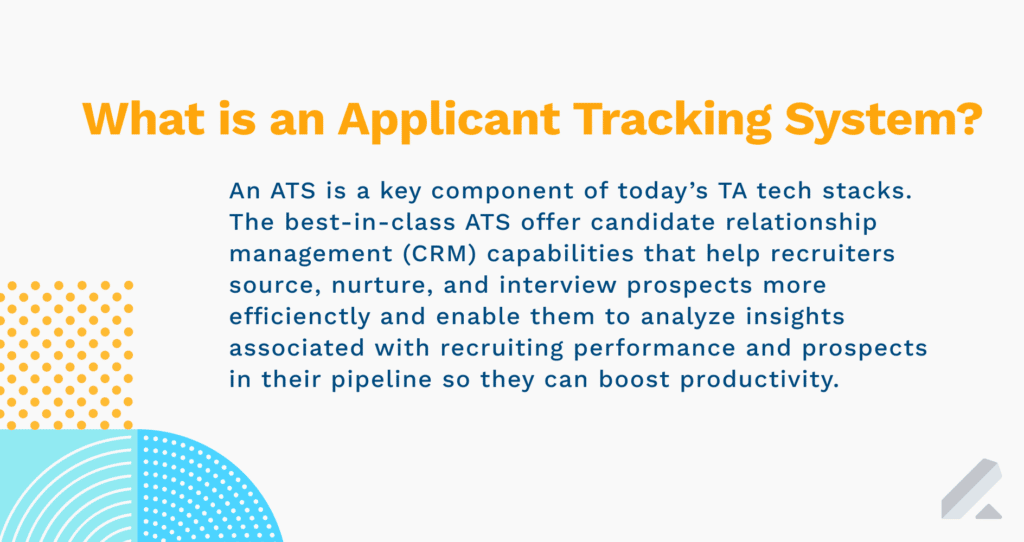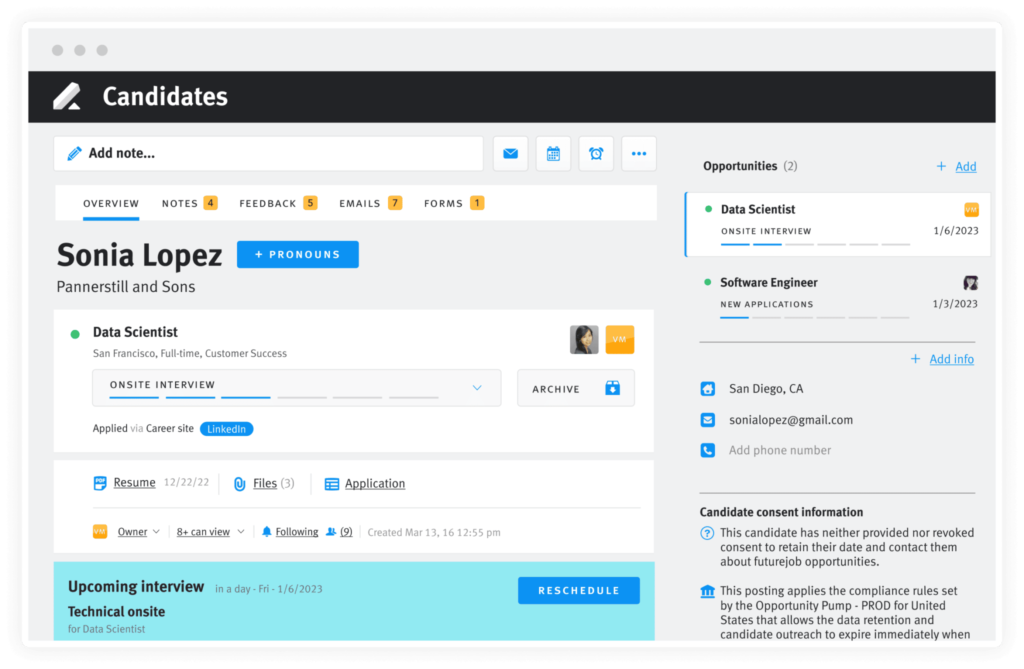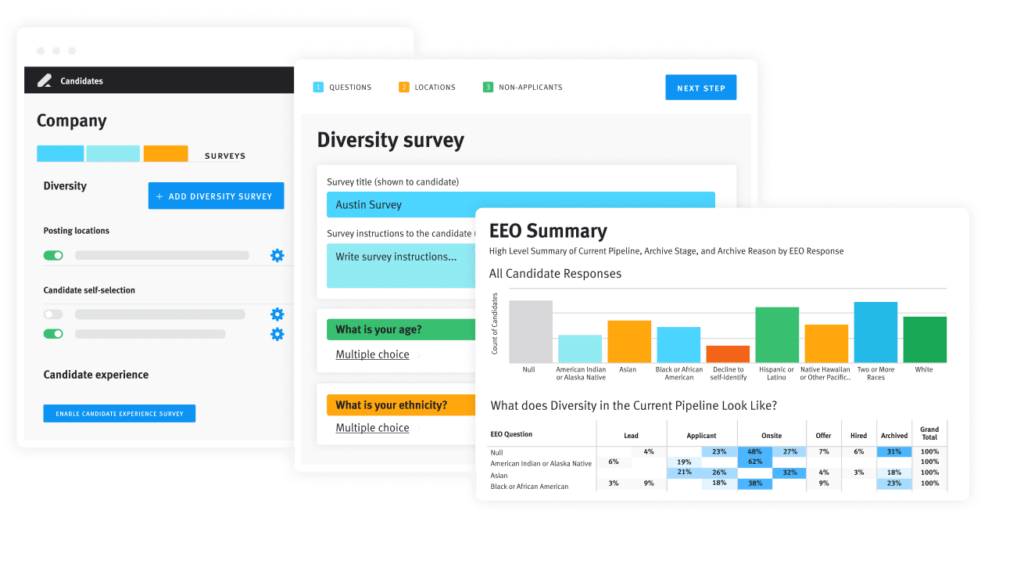Not every applicant tracking system (ATS) is the same. Some are clearly better than others.
The best ATS software help organizations of all kinds — not just Fortune 500 companies, but also small and scaling businesses — centralize info and data tied to qualified candidates of interest that updates dynamically in real-time.
In turn, this empowers recruiters and other hiring stakeholders to make smarter decisions regarding which potential candidates to engage and advance.
Whether you get tens, hundreds, or thousands of job applications monthly, you can benefit from using one of the best applicant tracking systems.
Simply put, an applicant tracking system work as a digital talent acquisition partner, so to speak, for employers of all sizes and across industries. Notably, ones that help them better source, nurture, interview, and evaluate prospects and fill job openings quickly and efficiently.
The key to finding and onboarding the right ATS for your org requires knowing how your TA team could leverage such a platform — and what distinct capabilities they need to succeed.

Why you need an applicant tracking system
Before diving into the features your next applicant tracking system requires to help your recruiters operate more effectively, let’s cover what an ATS offers employers like yours.
Beyond the obvious benefit of its namesake — tracking applicants — the best ATS solutions also empower recruiters to better identify, interact with, and analyze top talent and streamline a number of critical TA tasks through the use of built-in AI and automation capabilities.
“But, how do we know if we need an applicant tracking system?” In short, if you agree with the below sentiments regarding your current TA tech and approach, an ATS is right for you:
- “We can’t find and engage enough quality candidates to help us hit our team hiring goals.”
- “We find it hard to review candidates’ resumes, cover letters, experience, and education.”
- “We don’t have a great system in which we can secure and assess employee referrals.”
- “We have to manually add and organize candidate info in Excel and/or disparate tools.”
- “We don’t have strong communication and collaboration among all hiring team members.”
- “We lack full visibility into our collective talent pipeline and overall recruitment process.”
- “We know our hiring process is slow, but we don’t know which stages and steps to fix.”
- “We can’t share any in-depth insights with execs regarding our progress with hiring KPIs.”
- “We hear from candidates that the application process tied to our job postings is poor.”
You’d be hard-pressed to find a TA team today that wouldn’t recommend getting an applicant tracking system to help with all these elements of your recruiting and hiring efforts.

8 must-have applicant tracking system features
Now, you may be eager to start evaluating applicant tracking systems that can help your TA team in these areas tied to their day-to-day recruiting work and long-term hiring efforts.
Before you do, just be sure you know your distinct ATS use cases and needs — and ensure solutions you consider have advanced yet easy-to-use capabilities. With that in mind, here are eight must-have features to keep top of mind when researching ATS software.
1) Candidate sourcing
It’s not enough to post open roles on job boards or use LinkedIn to track applications. You also need to build a robust candidate pipeline. The right applicant tracking system can help you enrich this pipeline and grow your talent pool as you source and hire for roles.
Think about whether a prospective ATS allows you to store candidate info, quickly search for and reference candidates, create unified candidate profiles, and automate outreach.
2) Structured interviewing
Interviews take up a lot of time. That’s why your ATS needs features that streamline interviewing for both your team and candidates. For example, you’ll want to consider whether your ATS:
- Allows you to quickly schedule interviews and integrate with your team’s calendars
- Provides structured interview kits and prescriptive feedback forms
- Integrates with DEI tools like anonymous resume reviews
These interview features don’t just benefit your hiring team. They also provide a great candidate experience and ensure prospects stay informed throughout the recruiting process.

3) Candidate relationship management
It’s not uncommon to come across a candidate you want to hire, but one you simply don’t have the right role for yet. In cases like these, having a candidate relationship management solution (CRM) allows you to leverage that applicant down the road when the time is right.
A candidate relationship management tool also helps you build meaningful relationships with top talent through your applicant tracking system. That enables you to nurture your candidate pipeline without missing job seekers who could add to your culture, too.
A few features you should keep an eye out for include the ability to tag, filter, and search your candidate database. Additionally, determine if you can create workflows that allow you to view past outreach and easily stay in touch with active candidates.
4) Talent analytics
When so much about recruiting can be reactive, you want to be proactive when sourcing and hiring the right candidates.
But, without the insights necessary to make informed hiring decisions, you could be recruiting at high cost with little ROI. This is where deeper data comes into play.
Analytics tied to recruiting can help hiring teams better understand their candidate pipeline while focusing on diversity recruiting and tracking hiring progress, all in one tool.
Hiring dashboards that update in real-time with intricate data enable you to collect, store, and present insights are also beneficial with your org’s long-term workforce planning efforts.

5) Centralization of data
Between the endless spreadsheets, job descriptions, career sites and outreach, managing candidates is a laborious task — and that’s even before you get to the interview stage.
That’s why more recruiters and hiring managers are turning to advanced applicant tracking systems to centralize these efforts.
Centralization allows you to keep everything pertaining to candidates in one place — making it easier to create concise workflows where candidate profiles, feedback, interviews, communications and other essential details and notes are organized.
6) Diversity, equity, and inclusion (DEI)
It’s one thing to track and measure recruiting pipelines and performance. But, what about diversity, equity, and inclusion (DEI)?
Employers are growing more serious about diversity recruiting, which means hiring teams need access to deeper data that helps them drive progress with DEI.
Your applicant tracking system should be able to deliver these insights.
LeverTRM’s Advanced Analytics, for example, lets recruiters create custom surveys to collect feedback from candidates, while the EEO dashboards in Visual Insights provide — well — insights into the diversity of your talent pool and candidate pipeline.

7) Recruitment marketing
A big misconception about recruitment marketing is that it’s only comprised of what your company does on social media.
However, the reality of today’s hiring landscape is that recruitment marketing must encompass every touchpoint a candidate has with your org across the hiring life cycle.
This means every hiring process stage should align with your recruitment marketing, including job descriptions, careers pages, application forms/portals, and nurture campaigns.
8) Automation and personalization
Poor workflows deter productivity for TA teams looking to source, engage, nurture, and hire top talent at scale, especially when they create more work and manual tasks than necessary.
To ensure workflows ease the recruiting burden on your talent team, automation is key.
For example, setting up interview processes, collecting candidate feedback, scheduling meetings, and personalizing outreach at scale should be doable with just a few clicks.
The same goes for integrations that help you hire faster and enhance your high-volume hiring.
Need an applicant tracking system? Talk with our team today to learn all about our best-in-class recruiting software. We’ll walk you through our advanced ATS + CRM solution.




